An Air Stone, also known as a bubbler or a diffuser, is used in freshwater and saltwater aquariums to diffuse oxygen into the water via bubbles. This helps keep your fish breathing normally and, in most cases, helps provide adequate aeration to keep your biological filter up and running properly.
The goal of this guide is to explain where to place an air stone in an aquarium, how they can be used in freshwater and saltwater tanks, as well as what types are available on the market.
Where to place an air stone in an aquarium?
Where to place an air stone in an aquarium is an important question to answer if you want your aquarium to run smoothly and look beautiful.
An air stone can create bubbles of air, which add oxygen to the water, which in turn helps keep your fish healthy and thriving. The most obvious place to put an air stone in an aquarium would be at the bottom of the tank.
An air stone on the bottom of your aquarium can help you do that by encouraging proper oxygenation of the water, which helps your fish breathe more easily and effectively.
But there are many other locations you can use that will help keep the environment of your tank as stable as possible and get the most out of your air stone’s bubble-making abilities.
Things to know before placing an air stone in an aquarium
The first thing you will want to do is to find a good location for your air stone. This can either be placed on a ledge (if your tank has one) or just in front of a water flow like an intake/outtake system.
Do not place it directly into the water and try not to obstruct other openings as fish may get stuck when trying to swim through these areas.
After you have chosen where you would like your air stone to be, make sure that it is seated firmly, then turn on the pump and enjoy!
Be careful if being placed near an intake/outwash system, make sure it does not get sucked up into filter systems and cause any damage. If unsure about placement, consult with aquarium experts before doing anything else.
Why aquarium air stones are important
The air stones are important for a fish aquarium because they:
Provide fresh air to fish
Maintaining healthy levels of dissolved oxygen in an aquarium is essential for keeping fish alive and happy. If you're setting up a new aquarium or looking to upgrade your current setup, don't forget that there's more than just fish food and filter media that you'll need!
There are also several other important things you'll want to consider adding before you start stocking your tank with colorful aquatic life. One such item is an oxygenator—also known as an air stone or bubbler, which helps provide your aquatic pets with fresh air by generating tiny bubbles that rise through the water and release small amounts of oxygen into it.
Help your fish to alive
A fish tank is a closed environment, so it's very important to have adequate gas exchange at all times. While some forms of life can perform photosynthesis, it doesn't include most fish or invertebrates. If they stop breathing, they’ll die. That's where aquarium air stones come into play!
These ingenious devices use water flow to create fine bubbles that rise through your aquarium. The bubbles reach a critical size and burst in contact with air, generating small amounts of fresh oxygen for your underwater residents to breathe comfortably. It's pretty simple stuff, but understanding how it works will help you choose which type of air stone you should buy.
Types of air stones
There are several different types of air stones available on today's market. While some offer advantages over others, they all work to keep your aquarium safe, healthy, and full of life.
You can buy an air stone kit that includes everything you need to install your DIY bubble wall. You can also opt for an individual piece of equipment if you already have a set-up that works well or if you just prefer one style over another.
Here is a rundown of some popular styles:
1. Jet air stones
Jet air stones produce small but powerful streams of bubbles that make it easy to cover large areas with a consistent flow rate no matter where you aim them. Their efficiency makes them ideal for shallow tanks or tanks without built-in waterfalls.
They can also be used to create interesting effects like bubble curtains by placing them along edges. The downside is that they don’t last as long as other models, so you’ll need to replace them more often.
2. Bubble wands
These long tubes look like something out of Harry Potter's wand collection and create a wide range of bubbles of varying sizes depending on how close you hold them to your aquarium walls. They're great for creating custom water features and effects like fish tunnels (streams of bubbles) or bubble curtains.
However, since these wands must be held at specific angles to create certain effects, it takes some practice before you get good at using them effectively. They're also not as efficient as jet stones, making them best suited for smaller tanks.
The one important thing for every bubbler is you must know how and where to settle them in an aquarium. And this factor is also important for the maintenance of your air stone aquarium.
3. Submersible bubblers
This type of air stone sits directly inside your tank and creates gentle currents throughout. It provides a subtle effect that many people enjoy because it doesn't distract from their fish but still adds visual interest to their tank.
Another advantage is that submersible bubblers are very quiet, which means they won't disrupt your home or office environment while running.
Since they sit inside your tank, however, you should avoid using them in saltwater environments because they will corrode quickly in such harsh conditions.
4. Foam air stones
If you want to add extra aeration to a planted aquarium without adding too much visual impact then foam air stones might be right up your alley! Because they’re made of foam, you can cut them into any shape or size and place them anywhere in your tank.
They don’t last as long as other types of air stones, but they’re inexpensive enough that replacing them every few months isn’t a big deal. For those who only want to provide supplemental aeration without altering their entire setup, foam air stones are an excellent choice.
Conclusion
An air stone, also known as an air diffuser, can be used to aerate your aquarium and improve the quality of the water by getting oxygen into it. Because of this function, an air stone or diffuser also helps prevent any dangerous toxins from building up in the water and harming your fish.
This fish care guide tells you where to place an air stone in an aquarium. We should place an air stone on the bottom of our fish tank. If you correctly place an air stone, then it will give a healthy aquarium to your fish.
FAQs
How long can the bubble last?
When purchasing a fish tank, it is important to consider how long a single bubble will last. If you have a small tank, your bubbles may be on for more than an hour at a time and if you have a larger tank, they might only be on for 20 minutes at a time.
It is not just bubble duration that matters; however, it is also where these bubbles are placed inside of your fish aquarium. For example, placing them close to your filter or heater can cause damage due to over-heating.
Be sure to read all manufacturer instructions before deciding where you should place air stones in the aquarium.
How many bubbles do you need?
How many bubbles do you need depends on your fish aquarium tank setup? One air stone per 20-30 gallons of water is usually enough, but more bubbles are necessary if you want to support a higher bioload or an abundance of plants. Two stones will supply more than enough bubbles for most tanks.
What is a canister filter?
A canister filter performs the task of filtering the water in your aquarium and reducing waste products like nitrate and phosphate. It cleans the water of a fish aquarium and gives them a reliable environment.



Comments (0)
Back to Supplies & Equipment